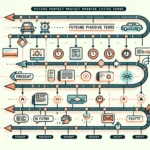“So as to” is a useful phrase that often appears in IELTS exams, particularly in Writing and Speaking tasks. Understanding its proper usage can help you express purpose more formally and elegantly, potentially boosting your score. Let’s explore how to use this structure effectively in your IELTS preparation and exam.
Understanding “So as to” and Its Frequency in IELTS
“So as to” is a formal way of expressing purpose, equivalent to “in order to” or “to”. It’s commonly used in academic and professional contexts, making it particularly relevant for IELTS Writing Task 2 and Speaking Part 3. While not as frequent as simpler alternatives, using “so as to” can demonstrate a higher level of language proficiency.
Examples:
- I wake up early so as to have enough time for breakfast. (Purpose in daily routine – Speaking Part 1)
- Many cities are implementing bike-sharing programs so as to reduce traffic congestion. (Urban planning solution – Writing Task 2)
- Students often participate in extracurricular activities so as to enhance their college applications. (Education topic – Speaking Part 3)
 IELTS Exam Preparation
IELTS Exam Preparation
Grammar and Usage: Mastering “So as to”
Formula and Structure
The basic structure for using “so as to” is:
[Subject] + [Verb] + [Object/Complement] + so as to + [Verb (base form)] + [Object/Complement]
It’s important to note that the verb following “so as to” is always in its base form, without “to”.
Application in IELTS Sections
-
Writing Task 2: Use “so as to” to express purpose in your argument or examples.
Example: “Governments should invest in renewable energy so as to reduce dependence on fossil fuels.” -
Speaking Part 2: Incorporate it into your long-turn answer to show purpose in actions or decisions.
Example: “I chose to study abroad so as to immerse myself in a different culture.” -
Speaking Part 3: Use it to discuss broader purposes in society or systems.
Example: “Many companies are adopting flexible working hours so as to improve employee satisfaction.”
Sample Passages and Sentences
Writing Task 2 Sample Paragraph
“In recent years, many cities have implemented extensive public transportation systems so as to address growing urban mobility challenges. By investing in efficient bus and metro networks, local governments aim to reduce traffic congestion and lower carbon emissions. Moreover, these initiatives often include bike-sharing programs so as to provide last-mile connectivity options. Such comprehensive approaches are crucial so as to create sustainable and livable urban environments for the future.”
Speaking Part 3 Sample Answer
Question: How can technology be used to improve education?
“Technology can be integrated into education in various ways so as to enhance learning experiences. For instance, interactive software can be employed so as to make lessons more engaging and tailored to individual student needs. Additionally, online platforms can be utilized so as to facilitate collaboration between students from different parts of the world, thus broadening their perspectives. Furthermore, virtual reality technologies can be implemented so as to provide immersive learning experiences, especially in subjects like history or science where visualization can greatly aid understanding.”
Strategies for Higher Band Scores
To achieve higher band scores (7+) in IELTS, use “so as to” alongside other complex structures and varied vocabulary. Compare these examples:
Band 6: “We need to plant more trees to reduce pollution.”
Band 7: “We need to implement extensive reforestation programs so as to mitigate air pollution and enhance biodiversity.”
Band 8: “It is imperative that we undertake comprehensive reforestation initiatives so as to not only combat air pollution but also to foster biodiversity and create sustainable ecosystems.”
The higher band examples demonstrate more sophisticated vocabulary, complex sentence structures, and a more nuanced understanding of the topic.
Common Mistakes to Avoid
-
Using “to” after “so as to”:
Incorrect: “He studied hard so as to to pass the exam.”
Correct: “He studied hard so as to pass the exam.” -
Using it with modal verbs:
Incorrect: “We should exercise regularly so as to can maintain good health.”
Correct: “We should exercise regularly so as to maintain good health.” -
Overusing “so as to” in a single paragraph or answer:
While it’s good to use this structure, overuse can make your writing or speaking seem repetitive. Vary your expressions of purpose. -
Using it in very informal contexts:
In Speaking Part 1 or informal writing tasks, simpler alternatives like “to” or “in order to” might be more appropriate. -
Forgetting the main verb:
Incorrect: “The company so as to increase profits.”
Correct: “The company implemented new strategies so as to increase profits.”
Conclusion
Mastering the use of “so as to” can significantly enhance your IELTS performance, particularly in Writing Task 2 and Speaking Part 3. Remember to use it alongside other complex structures and varied vocabulary to demonstrate a high level of English proficiency. Practice incorporating this phrase into your essays and speaking responses, always ensuring that you’re using it correctly and in appropriate contexts. By doing so, you’ll be well-prepared to express purpose and intention effectively in your IELTS exam.


